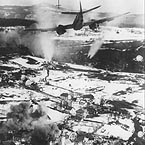DBS
Posts: 513
Joined: 4/29/2004
Status: offline

|
Have just checked some bits I posted (three years ago - eeek) on Jean-Claude's fora re BoB AA Command. Cut and pasted for ease:
1/ British AA defences, at least in terms of light and medium weapons - heavy is a whole different can of worms! - are probably too prolific. An RDF site with 3 Bofors and perhaps a dozen LMGs was considered to have the best point defence available.... Yes, AA Command had 3,538 light/medium guns in June 1940. But many of these went to sites outside the BoB target list. Small ports, for example, or searchlight batteries: given Lewis Guns for fear of strafing attacks. The single biggest concentration of Bofors was at Dowding's HQ at Bentley Priory - eight Bofors!
(Breakdown of June 1940 guns:
- 3028 x Lewis LMGs
- 37 x Hispano 20mm
- 114 x 2pdr pom-poms (mainly twin mounts I think)
- 132 x 3" modified for low-level work (different sights, fuses, etc. Other 3" guns were rated for medium work)
- 227 x Bofors 40mm)
2/ Radar stations are probably too vulnerable to bombing, at least on the South Coast where full infrastructure was most developed. Yes, Ventnor went off air, but the others took quite a pounding. Not a single mast came down. CHL stations will have been much less resilient, not least given their very hurried construction, but equally will have been much less obvious targets, with only 20 foot high gantries. One could almost argue that CHL should be non-targetable, along the lines of the HQs, with the CH rated for better hardening. Quite different to many of the German radars in BTR in terms of vulnerabilities.
3/ As in BTR, AA guns in BoB are allowed to get off far too many shots at low-level attackers. Some of the Bofors guns only reported 5-7 rounds fired during the heavy attacks! OK, British Army flak crews in 1940 a lot less experienced than some Luftwaffe flak crews of 1944, but on the other hand, the whole point of low-flying is to be spotted at the last moment. Instead of which, in BTR and BoB, raiders at, say, 400 feet get subjected to bursts of gunfire before they reach the target, then another burst over the target itself.
And a post giving a bit deeper detail:
In September 1939, RDF stations had highest priority of all on AA Command's list of Vulnerable Points. It may seem odd, but RAF airfields were only added to the list in summer 1940, their point defence being left up till then to RAF personnel and ad hoc loan of troops from nearby Army units.
Anyway, despite the appalling shortages of guns that AA Command suffered from, each of the 20 RDF stations in service in Sep 39 received three Bofors 40mm, the best Light AA Gun available. The entire Command only had 72 in total. This rose to 227 by June 1940.
Three Bofors per RDF site became the 1940 standard. During 1940, static structures were built for the guns, the RDF again getting highest priority. These structures included 10 to 30 foot flak towers where necessary to improve the field of fire. None of the old 3inch guns went to RDF sites: they were given to 12 Group Fighter Stations, plus the more vulnerable Bomber Command bases. By far the most common Light AA weapon was the Lewis Gun on a pedestal mount. Of 3538 light weapons in AA Command in June 1940, 3028 were Lewis Guns.
The defences at Dunkirk CH station on 12 August - when it was bombed - were the three Bofors, plus eleven Lewis MGs. The attacks of 12 August were studied in detail, because, although several RDF sites had been attacked, and they had the pick of the available guns, only one claim of a damaged Bf-110 had been reported. It was realised that the guns were often badly sited, with poor arcs of fire, particularly against low-level targets - AA Command had been very much the Cinderella during rearmament, and the crews were having very much to learn the hard way. Anyway, big improvements made to siting, etc.
|
 Printable Version
Printable Version














 From what i recall, its pretty much what you said....they came, they saw, they got instructed in the facts of life and didn't do too much else....similar to the Ju-87 experience. Not sure they'd be worth the effort of inclusion. Personally i'd rather see efforts concentrated on retrofitting BTR features to BoB's framework and correcting any nasty bugs before exploring minor details. Speedy's "Bingo fuel" bug worries me. Our BTR game would be ruined if he was being such a good sport about it.
From what i recall, its pretty much what you said....they came, they saw, they got instructed in the facts of life and didn't do too much else....similar to the Ju-87 experience. Not sure they'd be worth the effort of inclusion. Personally i'd rather see efforts concentrated on retrofitting BTR features to BoB's framework and correcting any nasty bugs before exploring minor details. Speedy's "Bingo fuel" bug worries me. Our BTR game would be ruined if he was being such a good sport about it. 






 New Messages
New Messages No New Messages
No New Messages Hot Topic w/ New Messages
Hot Topic w/ New Messages Hot Topic w/o New Messages
Hot Topic w/o New Messages Locked w/ New Messages
Locked w/ New Messages Locked w/o New Messages
Locked w/o New Messages Post New Thread
Post New Thread